Crape Myrtle Bushes: Types and Care (With Pictures)
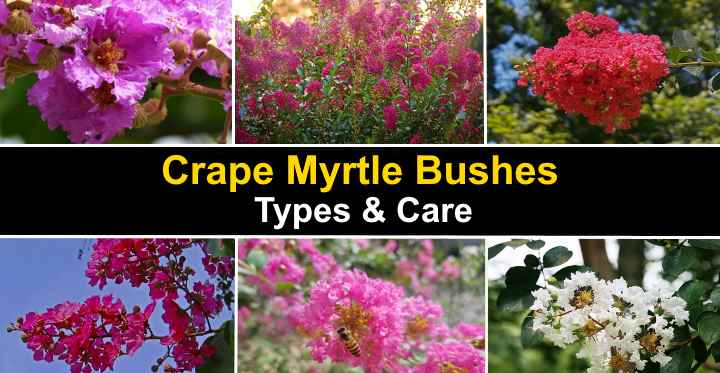
Crape myrtle bushes (Lagerstroemia indica) are attractive varieties of multi-stemmed flowering shrubs with showy red, white, pink or purple flowers. Crape myrtle shrubs flower in summer, turning the large bushes into colorful floral displays that attract birds and pollinators. You can grow ornamental crape myrtle bushes in warm climates. They are ideal plants for shrub borders, specimen plants, and container plants in beautiful garden landscapes.
Species of crape myrtle bushes can be small, compact dwarf shrubs or large, towering floral bushes. As long as you plant the shrubs in full sun and warm climates, crape myrtles will flower year after year. You can enjoy the large colorful flower panicles—clusters of spike-shaped flowers—from early summer until fall.
This article is a complete guide to popular types of crape myrtle bushes. Pictures of these shrubby plants and descriptions of their flowers, bark, and foliage will help to pick the ideal crape myrtle bush for your front or backyard. You’ll also find helpful tips on caring for crape myrtle shrubs.
What is Crape Myrtle Bush?
Crape myrtle bushes are fast-growing, small to medium-sized deciduous shrubs with multiple stems. Crape myrtles have a relatively compact growth habit with a spreading, vase-like shape and flat-topped growth. The attractive features of crape myrtle bushes are their flowers with crepe-like petals, orange or red fall foliage, and interesting pinkish-gray, mottled, peeling bark.
Crape myrtle bushes thrive in USDA zones 6 through 10. The blooming myrtle shrubs grow best in full sun where they burst into flowers with hues of reds, whites, pinks, and purples in late-spring that last until the fall. Some species of crape myrtles flower until the first frost. These hardy shrubs are tolerant of drought, light frost, and poor soil.
Crape Myrtle Bush Vs. Crape Myrtle Tree
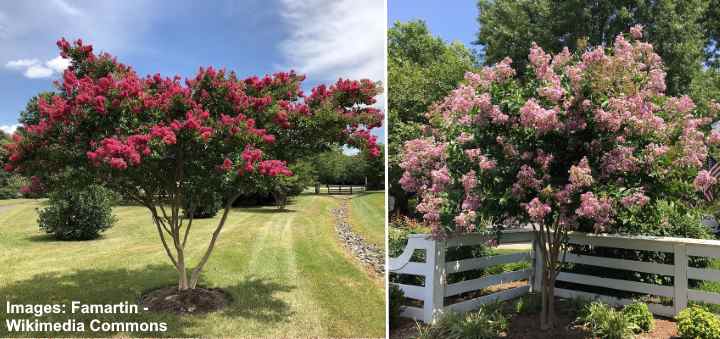
Crape myrtle bushes are smaller than trees and have multiple stems
The difference between the crape myrtle bush and the crape myrtle tree is that the tree is taller than crape myrtle bush. Crape myrtle bushes have multiple stems and their height is between 2 and 15 ft. (0.6 – 4.5 m). Crape myrtle trees can be as much as 20 ft. (6 m) taller than the bushes. Some crape myrtle trees can grow up to 35 ft. (10 m) high.
How Big do Crape Myrtle Bushes Get?
Dwarf crape myrtle bushes may be as short as two feet (0.6 m). The larger crape myrtle shrubs can be between five feet and 15 feet (1.5 – 4.5 m), depending on whether the bush is a semi-dwarf variety or a small shrub-like tree. Most types of flowering crape myrtle shrubs have a broad crown—usually more expansive than the bush is tall. The spread can be between five and 15 feet wide.
When Do Crape Myrtle Bushes Flower?
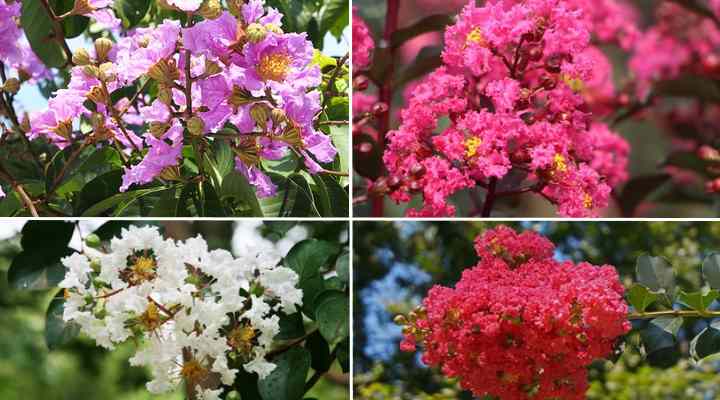
Crape myrtle flowers can be in shades of red, pink, purple and white
Most varieties of crape myrtle bushes flower from the middle of May or the start of June. Crape myrtle plants bloom for three or four months until the fall. Some of the hardiest crape myrtle bushes still have flowers when the first frost arrives.
Crape myrtle flowers are clusters of small flowers with wrinkled petals. Lagerstroemia’s common name “crape myrtle” or “crepe myrtle” comes from the thin, shriveled petals that are reminiscent of crepe paper. Similarly, their flowers resemble those of the species of true myrtle plants in the genus Myrtus.
Crape Myrtle Bush Leaves

Crepe myrtle leaves
The appealing leaves on crape myrtle shrubs are dark green in summer before turning yellow, orange, or red in the fall. The small deciduous, oval leaves measure up to 2” or 3” (5 – 7.5 cm) long and have rounded ends. Crape myrtle leaves have a pinnate growing arrangement and grow oppositely on stems.
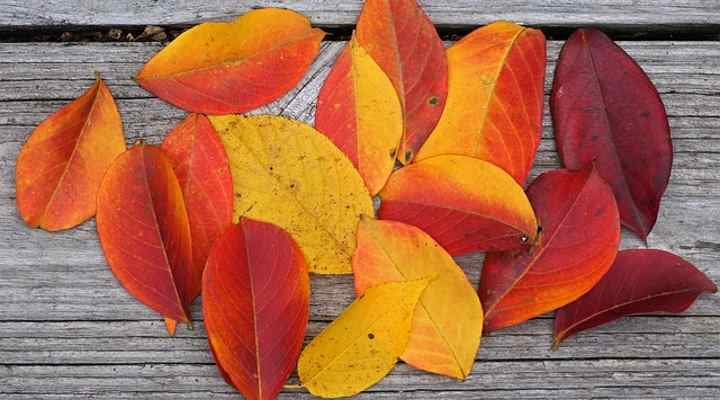
Crepe myrtle leaves in autumn
How to Care for Crape Myrtle Bushes
To care for crape myrtle bushes, grow the shrubs in full sun and well-draining soil. Crape myrtle bushes aren’t fussy about soil quality, as long as the ground doesn’t become waterlogged. Water the shrubby plant regularly to keep the ground moist. The best time to plant crape myrtle shrubs is in early spring or the fall.
Crape myrtle bushes need at least six hours of sunshine daily to bloom profusely. These shrubs can grow in partial shade; however, you’ll notice that they produce fewer flower clusters.
Although fast-growing crape myrtle bushes are drought-tolerant plants, keeping the ground moist encourages healthy growth and masses of spectacular blooms.
It would be best if you planted crape myrtle bushes far enough apart to allow plenty of air circulation. If the rounded crown has a spread of five feet (1.5 m), then space the shrubby bushed five feet apart. You can also plant multiple small or dwarf shrubs in a row to create a flowering privacy hedge.
Pruning Crape Myrtle Bushes
Pruning crape myrtle bushes helps encourage new growth, improve its appearance, and remove dead branches. However, crape myrtle bushes don’t require much pruning, apart from thinning its compact growth. Over-pruning crape myrtles can result in too much foliage and fewer flowers. If you decide to prune crape myrtle bushes, always trim them in winter.
If you want to plant crape myrtle trees to enhance your garden landscape, check the mature size of the shrub or tree. Crape myrtles grow best with little maintenance. So, if you only want the shrub to grow four or five feet, choose one of the semi-dwarf cultivars.
Types of Crape Myrtle Bushes (With Pictures)
Crape myrtle bushes (Lagerstroemia indica) are a beautiful addition to summer garden landscapes. The multi-stemmed shrub-like trees fill front or backyards with flowers that bloom throughout the summer. The compact growth of crape myrtle shrubs also adds to backyard privacy due to its dense foliage.
Tall Crape Myrtle Bushes (With Pictures)
Tall crape myrtle bushes are varieties of large shrubs, growing between 6 and 10 ft. (1.8 – 3 m) high. Let’s look in detail at some of the taller varieties of Lagerstroemia indica to enhance your garden’s aesthetics.
Acoma Crape Myrtle (Lagerstroemia indica x fauriei ‘Acoma’)
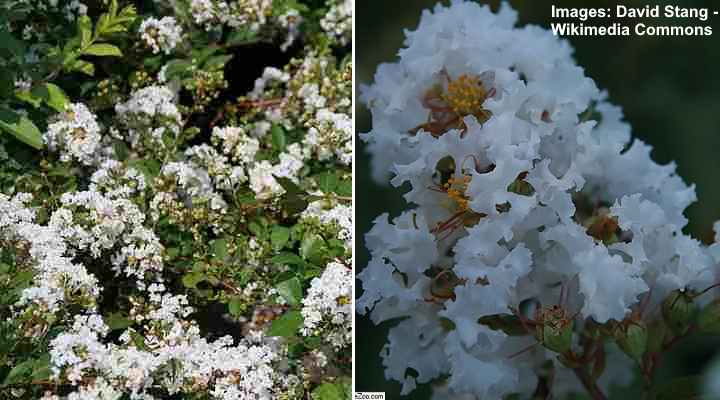
Acoma crape myrtle bush (left) and close up picture of the white flowers (right)
The Acoma crape myrtle is an attractive flowering shrub-like tree with white crinkled flowers. This tall deciduous shrub grows between 6 and 9 ft. (1.8 – 2.7 m) tall. The outstanding feature of Acoma crape myrtle is its slightly weeping growth habit. The drooping, pendulous branches produce shiny green leaves and cascading white flowers in summer.
Acoma crape myrtle shrubs or small trees have an umbrella-like rounded crown. The branches droop slightly, providing some shade underneath. The semi-dwarf trees have a large, spreading crown up to 11 ft. (3.3 m) wide.
From early summer until the fall, Acoma crape myrtles produce clusters of showy white flowers. The crepe-like petals turn the tree white, giving it an appearance of snow. In fall, the flowers drop, and the glossy green foliage turns a dark purple color.
Apalachee Crape Myrtle (Lagerstroemia indica ‘Apalachee’)
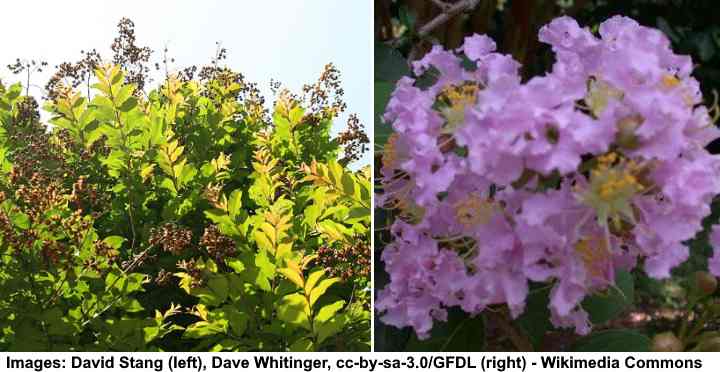
Apalachee crape myrtle shrub (left) and close up picture of the pale purple flowers (right)
The ‘Apalachee’ crape myrtle is a tall hybrid myrtle shrub that grows up to 12 ft. (3.6 m) high. This crape myrtle variety has clusters of light purple, lavender-colored flowers. ‘Apalachee’ crape myrtle shrubs flower from the middle of summer for three months. The dark green leaves become shades of red and orange in the fall.
The mature size of crape myrtle ‘Apalachee’ plants dramatically depends on the growing conditions. In warm zones and full sun, the tall crape myrtle shrubs reach 12 ft. (3.6 m). However, in USDA zones 5 and 6, the shrub has a significantly shorter height. Temperatures below freezing can cause the stems to die back to the ground.
Some smaller species of ‘Apalachee’ crape myrtle grow as dwarf shrubs, only reaching a few feet in height.
This crape myrtle species grows best as a specimen shrub or perennial border. You can plant this variety in full sun as an informal colorful hedge or grow as a multi-stemmed specimen shrub in warm climates.
Tonto Crape Myrtle (Lagerstroemia indica x fauriei ‘Tonto’)
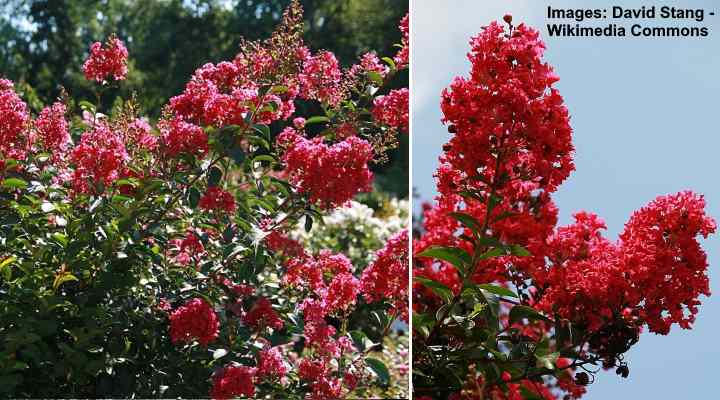
Tonto crape myrtle bush (left) and close up picture of the red flowers (right)
The ‘Tonto’ crape myrtle is a beautiful shrub with vibrant red crepe-paper-like conical flowers. This hybrid crape myrtle grows as a tall bush up to 10 ft. (3 m) high. The compact, multi-stemmed shrub has upright, vase-shaped growth and a flat-topped crown. Flowers appear on the tree in summer.
Crape myrtle ‘Tonto’ bushes grow best as specimen shrubs to provide rich colors in garden landscapes. The dense leafy foliage is a dark green that turns deep red in the fall. In winter, the shrub has mottled brown and tan-colored exfoliating bark.
Like most varieties of crape myrtle bushes, the ‘Tonto’ hybrid performs best in full sun. Once established, the hardy shrub is relatively tolerant of drought. But you will need to water it often in hot weather.
From the other varieties of crape myrtle, this hybrid is also disease resistant to powdery mildew—a disease that often affects this plant genus.
Catawba Crape Myrtle (Lagerstroemia indica ‘Catawba’)
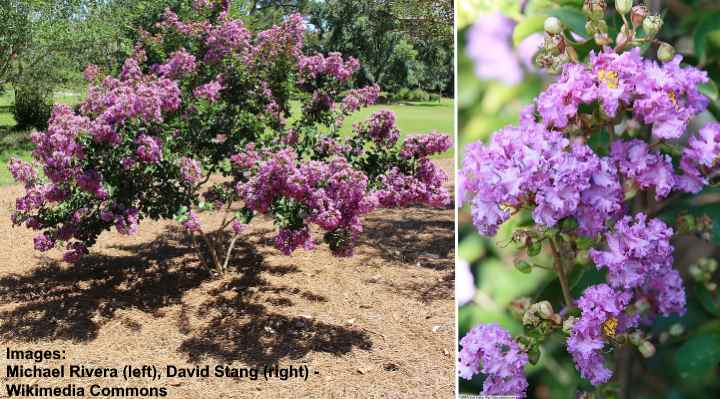
Catawba crape myrtle shrub (left) and close up picture of the purple flowers (right)
The Catawba crape myrtle is a spectacular variety of tall, colorful shrub. The vase-shaped growth has a wide-spreading crown that has dense, colorful foliage and flowers. ‘Catawba’ crape myrtle has crepe-like purple flowers. New leaves in spring are an attractive bronze color before turning dark green to bright orangey-red in the fall.
‘Catawba’ crape myrtles grow between 10 and 15 ft (3 – 4.5 m) tall. The multi-stemmed shrub has smooth cinnamon-colored bark, adding to its winter interest.
The outstanding feature of the ‘Catawba’ shrubs is their long-lasting, showy flowers. The shrub starts blooming in late summer, and the purple and lavender flower clusters last until the fall.
With the right care, you can also grow purple ‘Catawba’ crape myrtle as a single-stemmed tree. To grow this variety as a small landscaping tree, remove suckers every spring. Suckers are new growth that sprouts up around the base of the tree’s trunk.
Small Crape Myrtle Shrubs
Crape myrtle shrubs are perfect for growing in small, compact residential and urban gardens. Some of the smaller and dwarf varieties flower every year with colorful flower panicles. But the advantage of these small shrubs is that they only grow a few feet tall.
Chickasaw Crape Myrtle (Lagerstroemia indica x fauriei ‘Chickasaw’)
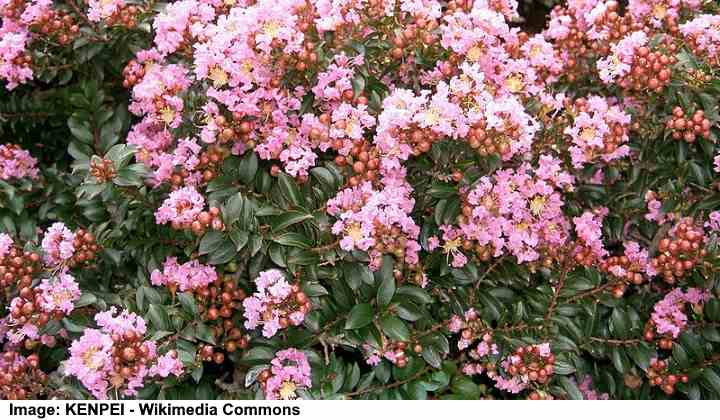
Chickasaw crape myrtle bush
The ‘Chickasaw’ crape myrtle shrub is a short plant that grows up to 2 ft. (0.6 m) tall. The compact small bush has masses of pinkish lavender showy flowers. This dwarf shrub adds bright garden colors to landscapes from late spring until frost. The other attractive features of the ‘Chickasaw’ crape myrtle are glossy, dense foliage, papery flowers, and short growth.
Grow ‘Chickasaw’ crape myrtle miniature bushes in USDA zones 7 through 9. The compact shrub will grow in zones 5 and 6, but you’ll need to protect the top growth from frost damage.
Due to its small size, the ‘Chickasaw’ crape myrtle shrub is a popular landscaping plant. You can use ‘Chickasaw’ bushes as foundation plantings, low-growing flowering hedges, or in containers for deck areas and patios. You can also plant ‘Chickasaw’ crape myrtles in rock gardens to add bright pink summer colors.
Petite Plum Crape Myrtle (Lagerstroemia indica ‘Monum’)
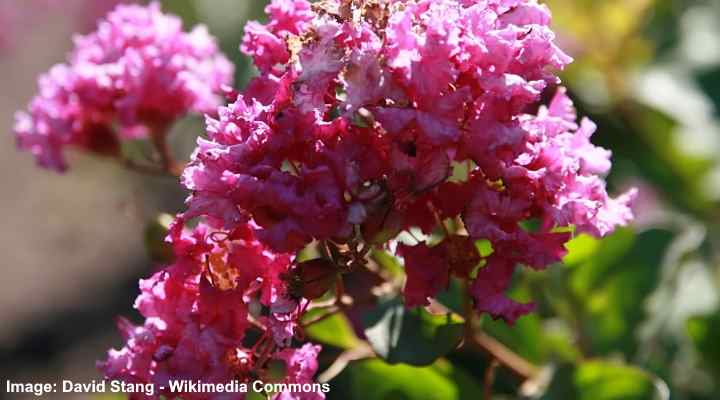
Petite Plum crape myrtle flowers
The Petite Plum crape myrtle variety is a dwarf tree growing as a large shrub. This cultivar grows up to 5 ft. (1.5 m) tall and has dense glossy-green foliage throughout the growing season. Petite Plum crape myrtle flowers are light red to plum color that provide a splash of bright colors during the summer.
Petite plum crape myrtle shrubs have branches and stems with upright growth habit and spreading vase shape. The shrub has a spread up to 4 ft. (1.2 m) wide. This variety of crape myrtle grows best in USDA zones 7 through 9. Although it tolerates drought, you need to give it plenty of water during hot sunny summer days.
With some pruning, the compact shrub is ideal for mass planting, flowering hedgerows, or growing in containers. The purple-dark pink flowers create plenty of floral interest when it’s in bloom throughout the summer
Crape Myrtle ‘Delta Blush’ (Lagerstroemia indica ‘Delta Blush’)
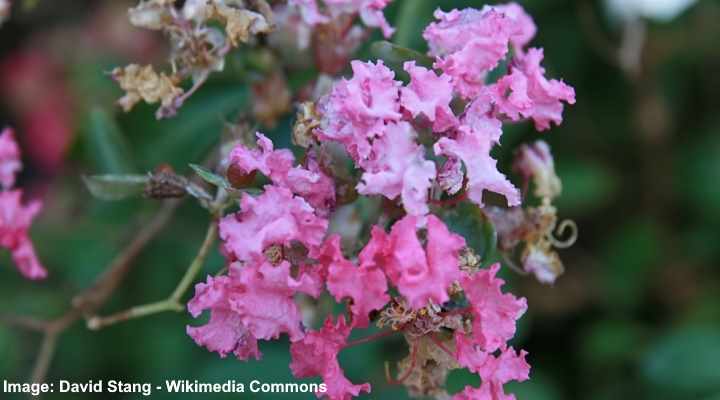
Crape Myrtle ‘Delta Blush’ pink flowers
The crape myrtle ‘Delta Blush’ is a miniature flowering shrub that only grows up to 1.5 ft. (0.5 m) tall. ‘Delta Blush’ crape myrtles have light pink flower clusters that add pastel tones to gardens from June through September. Another feature of this cultivar is its slightly drooping branches. As a small weeping crape myrtle, the ‘Delta Blush’ creates an explosion of cascading pink flowers.
Miniature crape myrtle plants like the ‘Delta Blush’ grow best as foundation plants, colorful borders, mass plantings, or in containers.
The densely branching growth of the crape myrtle ‘Delta Blush’ produces elliptic, oblong leaves that are up to 3” (7.5 cm) long. During summer, the dense green foliage contrasts with the vibrant pastel-colored flowers. Then in fall, leaves turn shades of red and orange before dropping. Due to its multi-colored peeling bark, the ornamental shrub also has plenty of winter interest.
Petite Orchid Crape Myrtle (Lagerstroemia indica ‘Monhid’)
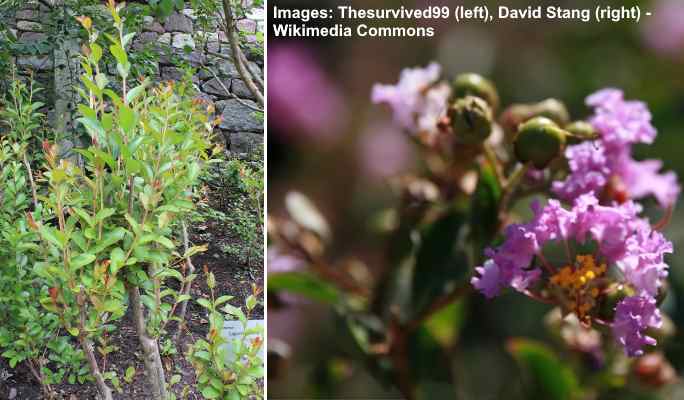
Petite Orchid crape myrtle bush and flowers
Another small crape myrtle bush is the Petite Orchid cultivar. The dwarf shrub produces crepe-like flowers that are a deep pink-purple color. Its fast growth and short stature make the Lagerstroemia petite orchid shrub best for planting at the front of the house, along borders, in rock gardens, or in containers.
How to Grow Crape Myrtle Bushes in Containers
Many small crape myrtle shrubs are excellent for growing in pots. The potted crape myrtle bushes thrive in a rich, all-purpose potting mix with excellent drainage. Place the container in a sunny spot in your garden, patio, entrance-way, or backyard. Water the plant daily during the summer to keep the soil evenly moist.
Growing crape myrtle bushes in containers is not difficult. To encourage healthy growth, use a balanced slow-release fertilizer for houseplants. Stop fertilizing about eight weeks before the first frost. In temperate climates, bring the potted crape myrtle indoors at the end of fall.
Crape Myrtle Hedge
Dwarf varieties or medium-sized crape myrtle bushes are ideal for growing as a flowering privacy screen. The thick foliage, bushy growth, and compact nature make for perfect natural screens. The best varieties for growing a grape myrtle hedge are Lagerstroemia indica x fauriei ‘Tonto,’ and Lagerstroemia indica ‘Monum.’
Related articles:
